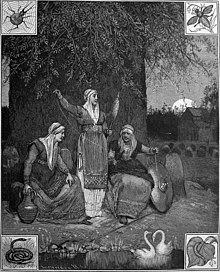And now for the absolute largest Viking hoard of silver treasure ever found (I should add: "so far"). In 1999, a Swedish television crew was filming a story on the looting of archaeological sites. They chose the location of Spillings farm, where 150 silver coins and bronze objects had been found not long before. They filmed a segment speaking to two men who happened to be working there with metal detectors: an archaeologist and a coin expert. They finished filming, the TV crew left, and the two experts continued exploring the site.
Twenty minutes after the TV crew left, the metal detector let out a very strong signal that there was metal underground. The men uncovered a small cache of silver. Two hours later and 10 feet away, the detector let out such a strong signal that it shut down. They cordoned off the area and notified the Gotland Museum; guards were posted and a request was made with authorities to begin an archaeological excavation. Over the next year, those two spots and a third found within a few feet from the original yielded the Spillings Hoard.
Excavation determined that the caches were buried under the floorboards of a building, probably in the 800s. The final yield was 14,295 silver coins, almost entirely Islamic dirhams. In all, 192 pounds of treasure was recovered, including 44 pounds of bronze scrap (intended for smelting later). There were also almost 500 bangles, mostly of Swedish design, but some with British and Western Scandinavian designs.
The area yielded evidence of habitation over several centuries, and digging turned up pieces of glass, tile, chains, needles, glass beads, iron nails, clothes pins, and polished semi-precious stones.
Bits of wood and iron embedded in the mass of coins suggest that they were originally contained in a wooden chest. Carbon-dating the wood led to a date of about 650CE, making it much older than the treasure it contained.
One startling piece is called the "Moses coin," a handful of which have been found. This is from the Khazar kingdom. The Khazars, mentioned here, were believed to follow Judaism, but evidence for this was lacking. This coin is inscribed with "Moses is the messenger of God" instead of the usual Muslim text "Muhammad is the messenger of God."
The presence of Islamic coins in several Viking hoards is explained when you remember that many Mediterranean people employed Vikings as mercenaries and guards. The Islamic dirham was widely used then in the Eastern and Southern coasts of the Mediterranean, and the name "dirham" for a coin is still in use today. I'd like to go into a little more detail about it tomorrow, and take a closer look at that Moses coin.
Until then, Happy New Year.





















